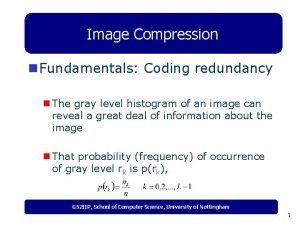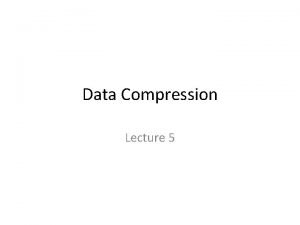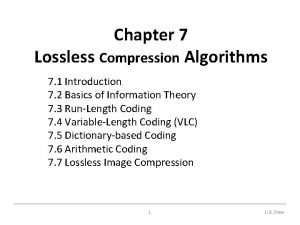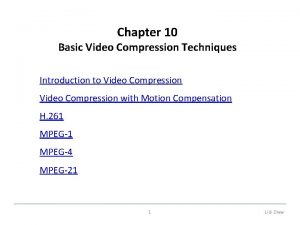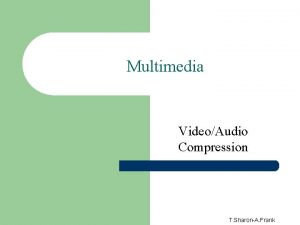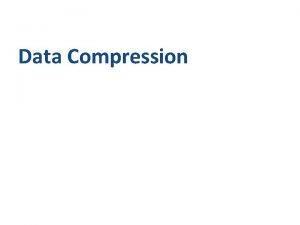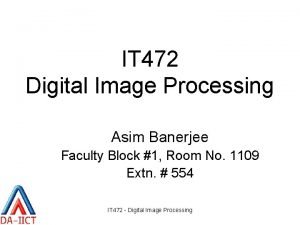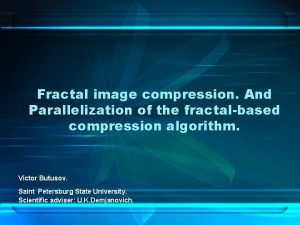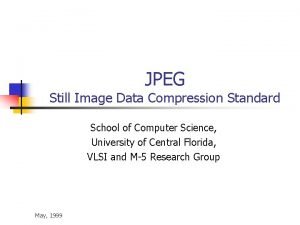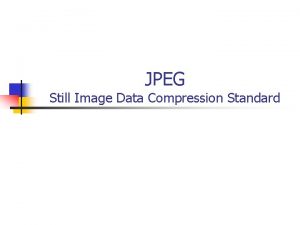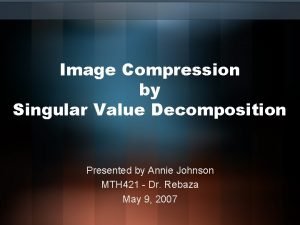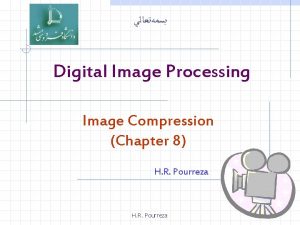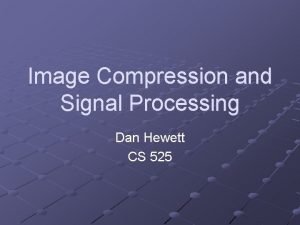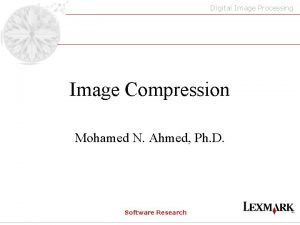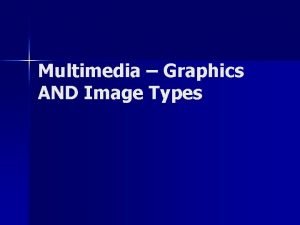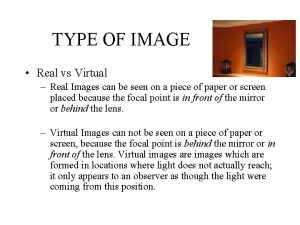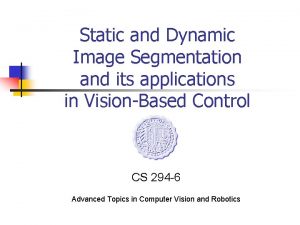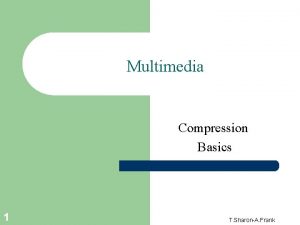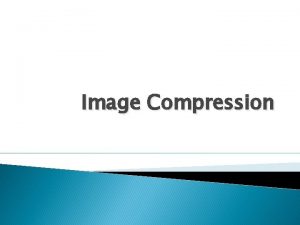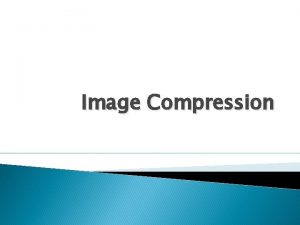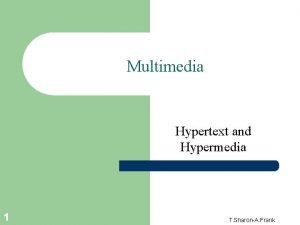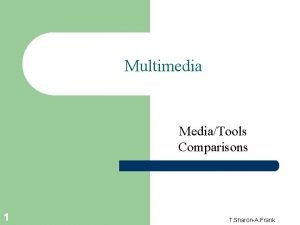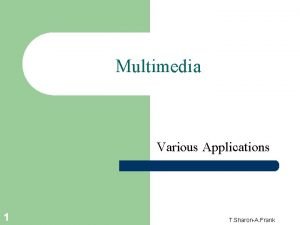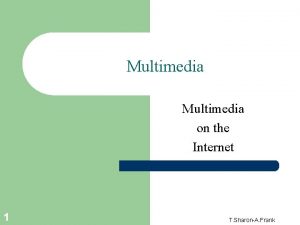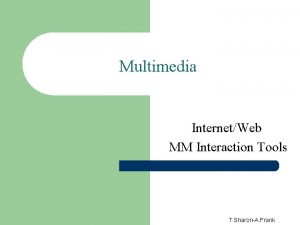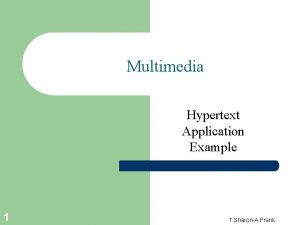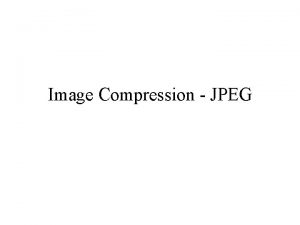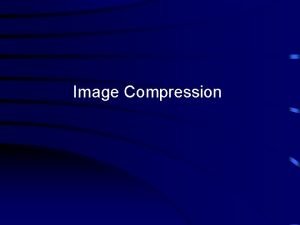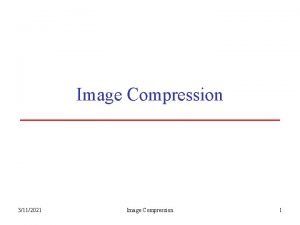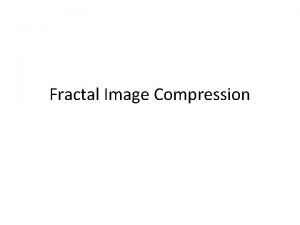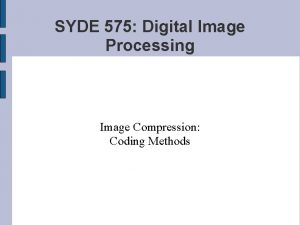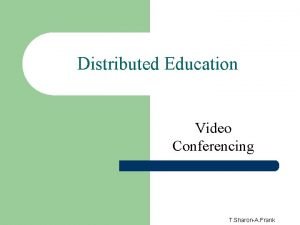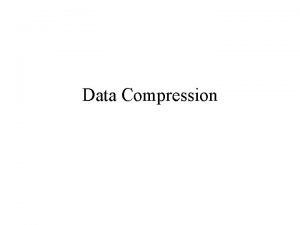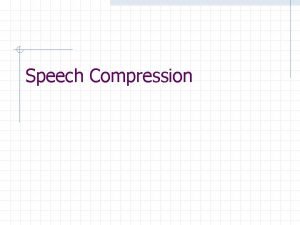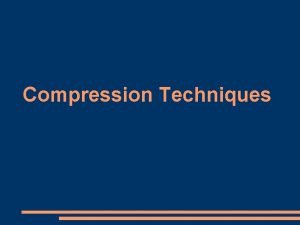Multimedia Image Compression 1 T SharonA Frank Coding




































- Slides: 36

Multimedia Image Compression 1 T. Sharon-A. Frank

Coding Techniques – Hybrid 2 T. Sharon-A. Frank

Hybrid coding • Images: – JPEG • Video/Audio – MJPEG – MPEG (1, 2, 4) – Other codings – H. 26 x 3 T. Sharon-A. Frank

Image Compression • Image files may be too big for network transmission, even at low resolutions. • Use more sophisticated data representation or discard information to reduce data size. • Effectiveness of compression will depend on actual image data. • For any compression scheme, there will always be some data for which 'compressed' version is actually bigger than the original. 4

Compression Steps Picture Image Preparation Uncompressed Picture Processing Quantization Entropy Encoding Image Compressed 1. Preparation: analog to digital conversion. 2. Processing: transform data into a domain easier to compress. 3. Quantization: reduce precision at which the output is stored. 4. Entropy encoding: remove redundant information in the resulting data stream. 5 T. Sharon-A. Frank

JPEG Joint Photographic Experts Group Goals: • Support still images • True color/grayscale • Continuous-tone pictures • Usually lossy 6 T. Sharon-A. Frank Subjects: • Quality • Steps • Modes

JPEG Picture Quality • 0. 25 – 0. 5 bits/pixel Moderate to good quality. • 0. 5 – 0. 75 bits/pixel Good to very good quality. • 0. 75 – 1. 5 bits/pixel Excellent quality. • 1. 5 – 2. 0 bits/pixel Usually indistinguishable from the original. 7 T. Sharon-A. Frank

JPEG Compression • Lossy technique, well suited to photographs, images with fine detail and continuous tones. • Consider image as a spatially varying signal that can be analysed in the frequency domain. • Experimental fact: people do not perceive the effect of high frequencies in images very accurately. • Hence, high frequency information can be discarded without perceptible loss of quality. 8

Stage 1: Image Preparation Components Sample s Left Cn C 2 * * * * Y * * * X i C 1 1<= n <=255, usually 3 9 Top T. Sharon-A. Frank Bottom Line j Right

3 components having the same resolution X X A 1 A 2 B 1 B 2 Y C 1 C 2 Y An 10 X Y Bn T. Sharon-A. Frank Cn

3 components having different resolution X A 1 A 2 Y X/2 B 1 B 2 C 1 C 2 Y An 11 Y Bn/2 T. Sharon-A. Frank Cn/2

Changing Resolution • If image resolution < output device resolution, must interpolate extra pixels – Always leads to loss of quality. • If image resolution > output device resolution, must downsample (discard pixels): – Quality will often be better than that of an image at device resolution (uses more information). – Image sampled at a higher resolution that of intended output device is over sampled. 12

Block Preparation (a) RGB input data. (b) After block preparation. 13 T. Sharon-A. Frank

Non Interleaved Order of Data Units MCU = Minimum Coded Unit Left Top * * * * * * * Bottom 14 T. Sharon-A. Frank * * * * Right

Interleaved Data Units 1 2 3 * * * 1 2 0 0 5* 0 1 2 1 15 0 5 * * * 3 * * * * 4 * * 3 * * 0 0 2* 1 2 3 1 * * * * 4 * * T. Sharon-A. Frank * * 0 1 0 2 1 * * *

Stage 2: Image Processing • • Using DCT (Discrete Cosine Transform) Convert from Spatial to Frequency Domain Input : 8 x 8 matrix of 64 values Output: – 1 DC value (basic color of block = average color) – 63 AC values • low frequency coefficients, have high values • high frequency coefficients – represent sharp edges, have low values 16 T. Sharon-A. Frank

Discrete Cosine Transform (DCT) 17 • A Fourier-related transform similar to the Discrete Fourier Transform (DFT), but using only real numbers. • Often used in signal and image processing. • Maps values from spatial domain to frequency domain – image areas with low frequency (large blocks of single color) are compressed more efficiently. • Used in JPEG, MPEG, and DV Compression. T. Sharon-A. Frank

DCT Dynamics • Analyses a signal into its frequency components. • Takes array of pixel values, produces an array of coefficients of frequency components in the image. • Computationally expensive process – time proportional to square of number of pixels. • Usually applied to 8 x 8 blocks of pixels. 18

JPEG: DCT-Based Encoder 8 x 8 blocks FDCT Source Image Data 19 Quantizer Table Specification T. Sharon-A. Frank Entropy Encoder Compressed Image Data Table Specification

Preparation of DC Coefficients DCi-1 DCi Blocki-1 Blocki DIFF=DCi-1 20 T. Sharon-A. Frank

DCT Transformation (a) One block of the Y matrix. (b) The DCT T. Sharon-A. Frank coefficients. 21

Preparation of AC Coefficients DC AC 01 AC 07 Zig-Zag Sequence AC 70 22 AC 77 T. Sharon-A. Frank

Probability Distribution of DCT Coefficients 1. 0 Probability of being nonzero 0. 5 23 0. 0 77 8 16 24 T. Sharon-A. Frank 32 40 48 Zigzag index 56

Next Stages • Stage 3: Quantization Based on quantization table: – Quantization table: values from 1 to 255 – DCT coefficient/Table value – If value > 0, keep DCT coefficient else, don’t keep DCT coefficient • Stage 4: Entropy Encoding 24 T. Sharon-A. Frank

JPEG Quantization • Applying DCT does not reduce data size – Array of coefficients is same size as array of pixels. • Allows information about high frequency components to be identified and discarded. • Use fewer bits (distinguish fewer different values) for higher frequency components. • Number of levels for each frequency coefficient may be specified separately in a quantization matrix. 25

Computation of the quantized DCT coefficients 26 T. Sharon-A. Frank

Order in which the quantized values are transmitted 27 T. Sharon-A. Frank

JPEG Entropy Encoding • After quantization, there will be many zero coefficients. – Use RLE on zig-zag sequence (maximizes runs). • Use Huffman coding of other coefficients (best use of available bits). 28

Steps of JPEG Compression Picture Preparation Picture Processing Pixel Predictor Block, MCU FDCT Entropy Encoding Quantization Run-Length Huffman Arithmetic Steps taking into account the different JPEG modes 29 T. Sharon-A. Frank

JPEG Decompression • Expand runs of zeros and decompress Huffmanencoded coefficients to reconstruct array of frequency coefficients. • Use Inverse Discrete Cosine Transform to take data back from frequency to spatial domain. • Data discarded in quantization step of compression procedure cannot be recovered. • Reconstructed image is an approximation (usually very good) to the original image. 30

JPEG: DCT-Based Decoder Compressed Image Data Entropy Encoder Table Specification 31 Dequantizer Table Specification T. Sharon-A. Frank IDCT Reconstructe d Image Data

JPEG Modes of Operation • Lossless Encoding: the image is encoded to guarantee exact recovery of every source image sample value (low compression ratio). • Sequential Encoding: each image is encoded in a single left-to-right, top-to-bottom scan. • Progressive Encoding: the image is encoded in multiple scans for applications in which transmission time is long. • Hierarchical Encoding: the image is encoded at multiple resolutions. 32 T. Sharon-A. Frank

Sequential Presentation 33 T. Sharon-A. Frank

Progressive Presentation 34 T. Sharon-A. Frank

Types of image processing in DCT Image display 35 Sequential Progressive successive Progressive spectral Bits per sample Entropy coding 8 8 12 12 12 T. Sharon-A. Frank 12 Huffman coding Arithmetic coding Huffman coding Arithmetic coding

Hybrid Coding Examples • JPEG – image compression using a discrete cosine transform, then quantization, then Huffman coding. • JPEG 2000 – image compression using wavelets, then quantization, then entropy coding. • MP 3 – A part of the MPEG-1 standard for sound and music compression, using subbanding and MDCT, perceptual modeling, quantization, and Huffman coding. 36 T. Sharon-A. Frank
 Apa itu selective coding
Apa itu selective coding Contoh open coding, axial coding selective coding
Contoh open coding, axial coding selective coding Coding redundancy works on
Coding redundancy works on Compression models in digital image processing
Compression models in digital image processing Image compression model in digital image processing
Image compression model in digital image processing Adaptive huffman code
Adaptive huffman code History of qualitative research
History of qualitative research Coding dna and non coding dna
Coding dna and non coding dna Lossless compression algorithms in multimedia
Lossless compression algorithms in multimedia Lossy compression
Lossy compression Video compression techniques in multimedia
Video compression techniques in multimedia Lossless compression in multimedia
Lossless compression in multimedia Hybrid coding in multimedia
Hybrid coding in multimedia Image compression
Image compression 472
472 Fractal image compression example
Fractal image compression example Jpeg: still image data compression standard
Jpeg: still image data compression standard Jpeg still image data compression standard
Jpeg still image data compression standard Singular value decomposition image compression
Singular value decomposition image compression Jpeg in digital image processing
Jpeg in digital image processing Signal image compression
Signal image compression Frank william abagnale jr. frank abagnale, sr.
Frank william abagnale jr. frank abagnale, sr. Multimedia becomes interactive multimedia when
Multimedia becomes interactive multimedia when What is linear multimedia
What is linear multimedia Csc253 interactive multimedia
Csc253 interactive multimedia Esa multimedia.esa.int./multimedia/virtual-tour-iss
Esa multimedia.esa.int./multimedia/virtual-tour-iss Digital image processing
Digital image processing Jpg type of multimedia
Jpg type of multimedia What are real and virtual image
What are real and virtual image Real vs virtual images
Real vs virtual images Translate
Translate Linear position invariant degradation
Linear position invariant degradation Image segmentation in digital image processing
Image segmentation in digital image processing Analog image and digital image
Analog image and digital image Image sharpening in digital image processing
Image sharpening in digital image processing Static digital image
Static digital image Geometric transformation in digital image processing
Geometric transformation in digital image processing


